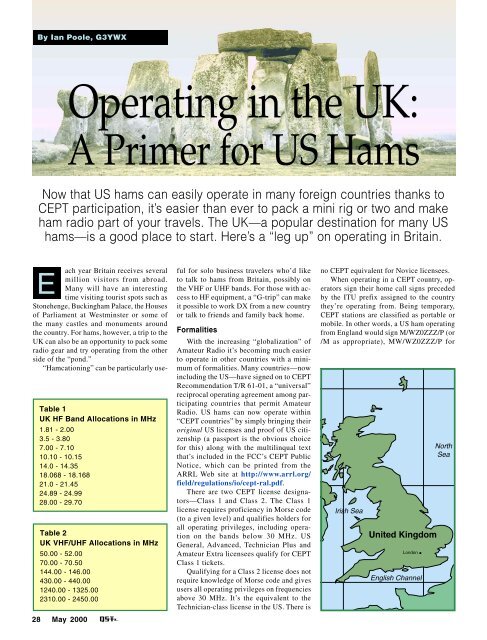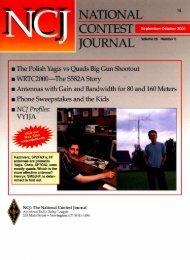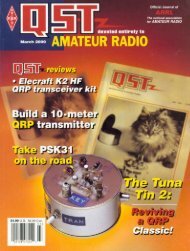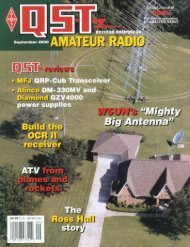By Ian Poole, G3YWXOperating in the UK:A Primer for US HamsNow that US hams can easily operate in many foreign countries thanks toCEPT participation, it’s easier than ever to pack a mini rig or two and makeham radio part of your travels. The UK—a popular destination for many UShams—is a good place to start. Here’s a “leg up” on operating in Britain.ach year Britain receives severalEmillion visitors from abroad.Many will have an interestingtime visiting tourist spots such asStonehenge, Buckingham Palace, the Housesof Parliament at Westminster or some ofthe many castles and monuments aroundthe country. For hams, however, a trip to theUK can also be an opportunity to pack someradio gear and try operating from the otherside of the “pond.”“Hamcationing” can be particularly use-Table 1UK HF Band Allocations in MHz1.81 - 2.003.5 - 3.807.00 - 7.1010.10 - 10.1514.0 - 14.3518.068 - 18.16821.0 - 21.4524.89 - 24.9928.00 - 29.70Table 2UK VHF/UHF Allocations in MHz50.00 - 52.0070.00 - 70.50144.00 - 146.00430.00 - 440.001240.00 - 1325.002310.00 - 2450.0028 <strong>May</strong> <strong>2000</strong>ful for solo business travelers who’d liketo talk to hams from Britain, possibly onthe VHF or UHF bands. For those with accessto HF equipment, a “G-trip” can makeit possible to work DX from a new countryor talk to friends and family back home.FormalitiesWith the increasing “globalization” ofAmateur Radio it’s becoming much easierto operate in other countries with a minimumof formalities. Many countries—nowincluding the US—have signed on to CEPTRecommendation T/R 61-01, a “universal”reciprocal operating agreement among participatingcountries that permit AmateurRadio. US hams can now operate within“CEPT countries” by simply bringing theiroriginal US licenses and proof of US citizenship(a passport is the obvious choicefor this) along with the multilinqual textthat’s included in the FCC’s CEPT PublicNotice, which can be printed from theARRL Web site at http://www.arrl.org/field/regulations/io/cept-ral.pdf.There are two CEPT license designators—Class1 and Class 2. The Class 1license requires proficiency in Morse code(to a given level) and qualifies holders forall operating privileges, including operationon the bands below 30 MHz. USGeneral, Advanced, Technician Plus andAmateur Extra licensees qualify for CEPTClass 1 tickets.Qualifying for a Class 2 license does notrequire knowledge of Morse code and givesusers all operating privileges on frequenciesabove 30 MHz. It’s the equivalent to theTechnician-class license in the US. There isno CEPT equivalent for Novice licensees.When operating in a CEPT country, operatorssign their home call signs precededby the ITU prefix assigned to the countrythey’re operating from. Being temporary,CEPT stations are classified as portable ormobile. In other words, a US ham operatingfrom England would sign M/WZ0ZZZ/P (or/M as appropriate), MW/WZ0ZZZ/P for
Table 32-Meter Channel DesignationsRepeater Input Channels145.000 RV48 (R0)145.025 RV50 (R1)145.050 RV52 (R2)145.075 RV54 (R3)145.100 RV56 (R4)145.125 RV58 (R5)145.150 RV60 (R6)145.175 RV62 (R7)Simplex Channels145.200 V16 (S8)145.225 V18 (S9)145.250 V20 (S10)145.275 V22 (S11)145.300 V24 (S12)145.325 V26 (S13)145.350 V28 (S14)145.375 V30 (S15)145.400 V32 (S16)145.425 V34 (S17)145.450 V36 (S18)145.475 V38 (S19)145.500 V40 (S20)—calling channel145.525 V42 (S21)145.550 V44 (S22)145.575 V46 (S23)Table 470-Centimeter Channel DesignationsRepeater Output Channels Simplex Channels433.000 RU240 (RB0) 433.400 U272 (SU16)433.025 RU242 (RB1) 433.425 U274 (SU17)433.050 RU244 (RB2) 433.450 U276 (SU18)433.075 RU246 (RB3) 433.475 U278 (SU19)433.100 RU248 (RB4) 433.500 U280 (SU20)433.125 RU250 (RB5) —calling channel433.150 RU252 (RB6) 433.525 U282 (SU21)433.175 RU254 (RB7) 433.550 U284 (SU22)433.200 RU256 (RB8) 433.575 U286 (SU23)433.225 RU258 (RB9) 433.600 U288 (SU24)433.250 RU260 (RB10)433.275 RU262 (RB11)433.300 RU264 (RB12)433.325 RU266 (RB13)433.350 RU268 (RB14)433.375 RU270 (RB15)Wales, etc. Effectively, an operation is portablewhen it’s staged from a “temporary”location and mobile when it’s from a vehicle(or even when walking). No maritime oraeronautical mobile operation is permitted.M Call SignsIf you’d like to stay a little longer inthe UK, consider applying for an “M” license.An application should be made to the RadioLicensing Centre, POCM, PO Box 885,Bristol, BS99 5LG, UK. Use the appropriateform and enclose £15 Sterling, your originalUS license and your UK station address(which can be a hotel). It’s possible to quotea US mailing address if you want to renewyour license (done annually).BandsMost traveling hams will probably usethe VHF/UHF bands because it’s so easyto pack a small hand-held radio. DiehardHFers, however, will want to look over theUK band allocations in Table 1. In general,power output is limited to 26 dBW (400 W).Between 1.850 and 2.000 MHz the limit isonly 15 dBW.Repeater Output Channels145.600 RV48 (R0)145.625 RV50 (R1)145.650 RV52 (R2)145.675 RV54 (R3)145.700 RV56 (R4)145.725 RV58 (R5)145.750 RV60 (R6)145.775 RV62 (R7)Repeater Input Channels434.600 RU240 (RB0)434.625 RU242 (RB1)434.650 RU244 (RB2)434.675 RU246 (RB3)434.700 RU248 (RB4)434.725 RU250 (RB5)434.750 RU252 (RB6)434.775 RU254 (RB7)434.800 RU256 (RB8)434.825 RU258 (RB9)434.850 RU260 (RB10)434.875 RU262 (RB11)434.900 RU264 (RB12)434.925 RU266 (RB13)434.950 RU268 (RB14)434.975 RU270 (RB15)At VHF and UHF, a slightly greaterknowledge of band plans, channel allocationsand operating conventions comes inhandy. Because 2 m and 70 cm are the mostpopular, details for those bands are shownin Table 2.The bands have channels allocated forrepeater and simplex operation. These haveletter designations so they can be easilyidentified. Repeater channels start withthe letter R; simplex channels with a V on2 m and a U on 70 cm. Although 2 meterssupports 12.5-kHz channel spacing, thiswill not be fully implemented until June30, <strong>2000</strong>. The introduction of this tighterchannel spacing has mainly been drivenby the need for more repeater channels(to reduce repeater channel re-use andinterference).It’s also worth noting that operation isnot permitted on frequencies between 431and 432 MHz within a 100-km radius ofCharing Cross in the center of London.Fortunately, there is little activity on thesefrequencies anyway, and neither simplexnor repeater channels are affected by thisrestriction. See Tables 3 and 4 for 2-meterand 70-centimeter channel designators.What to ExpectHF operation from the UK isn’t too differentfrom that in the US, but the backgroundinterference is different, and stationsfrom around Europe are quite strong.If you’re an experienced US VHF/UHFoperator you won’t have any difficulty operatingin the UK, although things may havea slightly different “feel” to them. Activityis sparse compared to many areas of the US,although when people are traveling to andfrom work the bands perk up. It may besurprising, but even around London duringweekdays there are not many stations to beheard during the day. At times like thesethe best way to prompt a contact is to makea call through a repeater—an American accentis sure to generate some interest!Final ThoughtsOne point you’ll have to remember is thatthe ac mains in the UK put out 230 voltsand require connectors that are different thanthose used in the US. This is even importantfor powering hand-helds, becauseunless you’re using disposable cells, the batterieswill need charging sooner or later. Theplug size problem can be overcome by usinga “shaver adapter,” available from mostelectrical retailers for a small sum. It’s stillnecessary to make sure that the voltage canbe accommodated. Most US RadioShackstores sell a plug and voltage converter kitsuitable for most low-power devices.When packing your equipment rememberthat hand-held radios should be carriedas hand luggage and not packed away in asuitcase. After the Lockerbie disaster, airlinesecurity workers are leery of radiospacked in suitcases.Guide to VHF/UHF Amateur Radio by IanPoole is due to be published at press timeby the RSGB. It gives details of operatingin the UK as well as information valuableto anyone using the VHF and UHF bands.You can contact the author at 5 Meadway,Staines, Middlesex, TW18 2PW, UnitedKingdom; ian-poole@lineone.net.<strong>May</strong> <strong>2000</strong> 29
- Page 6 and 7: May 2000 Volume 84 Number 5David S
- Page 11 and 12: THE AMERICAN RADIORELAY LEAGUE INC
- Page 14: Get to Know Your Section ManagerThe
- Page 18: The ARRL and the FCC’s Private Wi
- Page 22 and 23: The postman always keys twice.Accor
- Page 26 and 27: CORRESPONDENCEYour opinions count!
- Page 32 and 33: By Roger Sullivan, WA0ETE, and Hugh
- Page 34 and 35: By Jim Graver, KB8PSO2000Dayton Ham
- Page 36 and 37: Figure 1A—Schematic of the interf
- Page 38 and 39: All input/output connections are ma
- Page 40 and 41: Figure 4—Hanger loopconstruction.
- Page 42 and 43: Figure 2—A GOES-8 picture capture
- Page 44 and 45: By Steve Ford, WB8IMYPSK31 2000In e
- Page 46 and 47: the software, PSK31 tuning required
- Page 48 and 49: WORKBENCHPROJECTS AND INFORMATION F
- Page 50 and 51: By Martin A. Minow, K6MAMPractice M
- Page 52 and 53: the download to a suitable location
- Page 54 and 55: 52 May 2000SHORT TAKESHeil Sound Go
- Page 56 and 57: By Zack Lau, W1VTA No-Tune 2-Meter
- Page 58 and 59: HINTS & KINKSA FOLD-DOWN MOBILE-ANT
- Page 60 and 61: By James Kates, N9GBBConfessions of
- Page 62 and 63: PRODUCT REVIEWKenwood TM-D700A Dual
- Page 64 and 65: is accomplished by using OK, BACK a
- Page 66 and 67: other radio operation. The chatter
- Page 68 and 69: operation because there’s so litt
- Page 70 and 71: consideration in the WT Docket 98-1
- Page 72 and 73: News in Brief:• League members no
- Page 74 and 75: communications tests in celebration
- Page 76 and 77: I’ve done this tour several years
- Page 78 and 79:
The Crystal Symphony at anchor off
- Page 80 and 81:
Table 1Claimed North American Dista
- Page 82 and 83:
Okay in My LogBy Vic Curtis,WA3YUVP
- Page 84 and 85:
their 432 MHz triumph of the previo
- Page 86 and 87:
2000 ARRL Field DayRulesBy Dan Hend
- Page 88 and 89:
Collecting Vintage QSLsOLD RADIOAn
- Page 90 and 91:
DIGITAL DIMENSIONAPRS Digipeater in
- Page 92 and 93:
AT THE FOUNDATIONWhy We Fund Museum
- Page 94 and 95:
It is with deep regret that we reco
- Page 96 and 97:
COMING CONVENTIONSARRL NATIONAL CON
- Page 98 and 99:
checking; handicapped accessible; f
- Page 106:
of the West Allis ARC and served as
- Page 110:
introduced that could of had a bear
- Page 114:
211/109; NJN/L 29/203/103; CJTN 29/
- Page 118:
W1PEX 1048, WA1JVV 143, N1NH 105, W
- Page 124:
an activity we enjoy so much can be
- Page 128:
126He is President of the Amateur R
- Page 132:
is Walt Bacon, N6SMT, who is curren
- Page 150:
Ham Adsl) Advertising must pertain
- Page 154:
BAHAMAS RENTAL: Abaco villa w/stati
- Page 164:
“EVERYTHING FOR THE MORSE ENTHUSI
- Page 168:
TUBES WANTED: Highest prices paid o
















